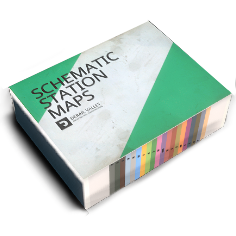Mechanical Transmission/en: Difference between revisions
Updating to match new version of source page |
Updating to match new version of source page |
||
| (2 intermediate revisions by the same user not shown) | |||
| Line 1: | Line 1: | ||
<languages /> | <languages /> | ||
{{ | {{pll|Rail Vehicle Types|Motorized rail vehicles}} with diesel-mechanical {{pll|Powertrains Overview|powertrains}} are powered by onboard {{pll|Internal Combustion Engine|diesel engines}} and propelled by mechanical transmissions. The engine power is conveyed to the wheels using a gearbox, similar to that of large road vehicles. | ||
With this type of powertrain, the {{pll|Throttle|throttle}} controls the engine speed. The power from the engine is mechanically transmitted to the wheels through a gearbox. | |||
With the vehicle in first gear, | With the vehicle in first gear, even low throttle propels it forward with relative ease, but it isn't able to reach a high speed just yet. You can make the vehicle reach higher speeds by shifting gears, but the faster it goes, the harder it accelerates. Gear ratios are designed to be used sequentially, so that the peak power of the engine is utilized as much as possible in each suitable gear, at all speeds. | ||
Gear selection is typically done by operating a lever. Some vehicles | Gear selection is typically done by operating a lever. Some vehicles have multiple gear selectors, depending on the gearbox design and usage. To avoid {{pll|Mechanical Powertrain Damage|damage}} when changing gears, throttle must be fully disengaged. | ||
On vehicles with mechanical transmission the load on the wheels | On vehicles with mechanical transmission the load on the wheels is closely tied to the engine. While diesel-mechanical vehicles have a fluid coupling that helps prevent stalling at a standstill, they can still stall under heavy load. For example, if you take off in too high of a gear, the engine won't have enough power to propel the vehicle, its rotational speed would drop below the minimum tolerance, and stalling will occur. | ||
In order to appropriately time the gear changes while on the move, it is necessary to monitor the RPM gauge. Upshifting should be done when the needle | In order to appropriately time the gear changes while on the move, it is necessary to monitor the RPM gauge. Upshifting should be done when the needle rises close to the red line, and downshifting should be done when the needle is close to the idle RPM, and the engine is losing power. | ||
Any load on the fluid coupling, either from the wheels or from the engine trying to accelerate or slow down, will | Any load on the fluid coupling, either from the wheels or from the engine trying to accelerate or slow down, will warm up the transmission fluid. Depending on the session {{pll|Difficulty|difficulty settings}}, fluid coupler can {{pll|Mechanical Powertrain Damage|fail catastrophically}} if it {{pll|Powertrain Overheating|overheats}}. | ||
{{ | Due to the relatively firm link between engine and wheels, diesel-mechanical vehicles benefit from being able to utilize {{pll|Engine & Compression Brake|engine and compression brakes}}. | ||
[[Category:Diesel-Mechanical]] | |||
[[Category:Diesel-Mechanical|1]] | |||
Latest revision as of 23:16, 17 March 2025
Motorized rail vehicles with diesel-mechanical powertrains are powered by onboard diesel engines and propelled by mechanical transmissions. The engine power is conveyed to the wheels using a gearbox, similar to that of large road vehicles.
With this type of powertrain, the throttle controls the engine speed. The power from the engine is mechanically transmitted to the wheels through a gearbox.
With the vehicle in first gear, even low throttle propels it forward with relative ease, but it isn't able to reach a high speed just yet. You can make the vehicle reach higher speeds by shifting gears, but the faster it goes, the harder it accelerates. Gear ratios are designed to be used sequentially, so that the peak power of the engine is utilized as much as possible in each suitable gear, at all speeds.
Gear selection is typically done by operating a lever. Some vehicles have multiple gear selectors, depending on the gearbox design and usage. To avoid damage when changing gears, throttle must be fully disengaged.
On vehicles with mechanical transmission the load on the wheels is closely tied to the engine. While diesel-mechanical vehicles have a fluid coupling that helps prevent stalling at a standstill, they can still stall under heavy load. For example, if you take off in too high of a gear, the engine won't have enough power to propel the vehicle, its rotational speed would drop below the minimum tolerance, and stalling will occur.
In order to appropriately time the gear changes while on the move, it is necessary to monitor the RPM gauge. Upshifting should be done when the needle rises close to the red line, and downshifting should be done when the needle is close to the idle RPM, and the engine is losing power.
Any load on the fluid coupling, either from the wheels or from the engine trying to accelerate or slow down, will warm up the transmission fluid. Depending on the session difficulty settings, fluid coupler can fail catastrophically if it overheats.
Due to the relatively firm link between engine and wheels, diesel-mechanical vehicles benefit from being able to utilize engine and compression brakes.
